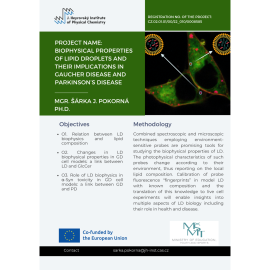Dr. Šárka J. Pokorná has been awarded the MSCA Fellowships CZ
Dr. Šárka J. Pokorná has been awarded the MSCA Fellowships CZ under the Operational program Jan Amos Komenský co-funded by the European Union and Ministry of Education, Youth and Sports (MEYS). She is now successfully continuing her work on the biophysical properties of lipid droplets (LD) and their role in Gaucher´s disease (GD) and Parkinson's disease (PD) under the supervision of Professor Martin Hof at the Department of Biophysical Chemistry. Her research, which began during her postdoctoral fellowship at the Weizmann Institute in Israel, focused on elucidating the relationship between the biophysics of LDs and their lipid composition. The current project seeks to uncover new insights into LD-related cellular processes that could help identify future therapeutic targets for treating GD, PD and other related disorders.
What are lipid droplets (LDs) in general? They are ubiquitous dynamic organelles composed of a neutral lipid core containing mainly cholesterol esters (CE) and triacylglycerides (TAG), surrounded by a monolayer of phospholipids including various proteins. LDs have long been considered a passive reservoir of fats that cells use for energy production. However, many new studies are revealing that LDs may be active players in serious diseases including Parkinson's disease (PD), cancer and obesity through a previously unknown mechanism.
Experimental data preceding this project demonstrated LD accumulation in cellular models of Gaucher´s disease (GD), whose biophysical properties differ from LDs in healthy cells. Variations in LD properties and lipid composition may regulate LD interactions with other organelles, thus allowing them to reprogram lipid and energy metabolism to meet cellular requirements.
In collaboration with the laboratory of Liana C. Silva at the University of Lisbon, it has been shown that the commercially available solvatochromic probe Laurdan, generally used to study membrane fluidity, is also suitable to address the biophysics of LD. Using the generalised polarisation (GP) of Laurdan, it is possible to observe property changes in model LDs with different lipid compositions (TAG and CE) and LD changes in living cells in response to nutritional changes and pathological conditions. These observations show the potential for broad application of Laurdan in LD cell biology studies. However, appropriate strategies to correlate the photophysical properties of the probes with LD composition and their biological functions remain to be developed.
To meet this need, Šárka seeks to apply a bottom-up, multidisciplinary approach where fluorescence spectroscopy and microscopy techniques will be used to determine the photophysical properties of Laurdan (and other suitable fluorescent probes) in model LDs with controlled lipid composition. These fluorescent fingerprints, characteristic for specific lipid compositions, can then be used to study living cells, providing insight into LD biology with high spatiotemporal resolution. Using the methodology developed in this project, it will be possible to investigate changes in LD in response to physiological, pathological and therapeutic impulses.






























